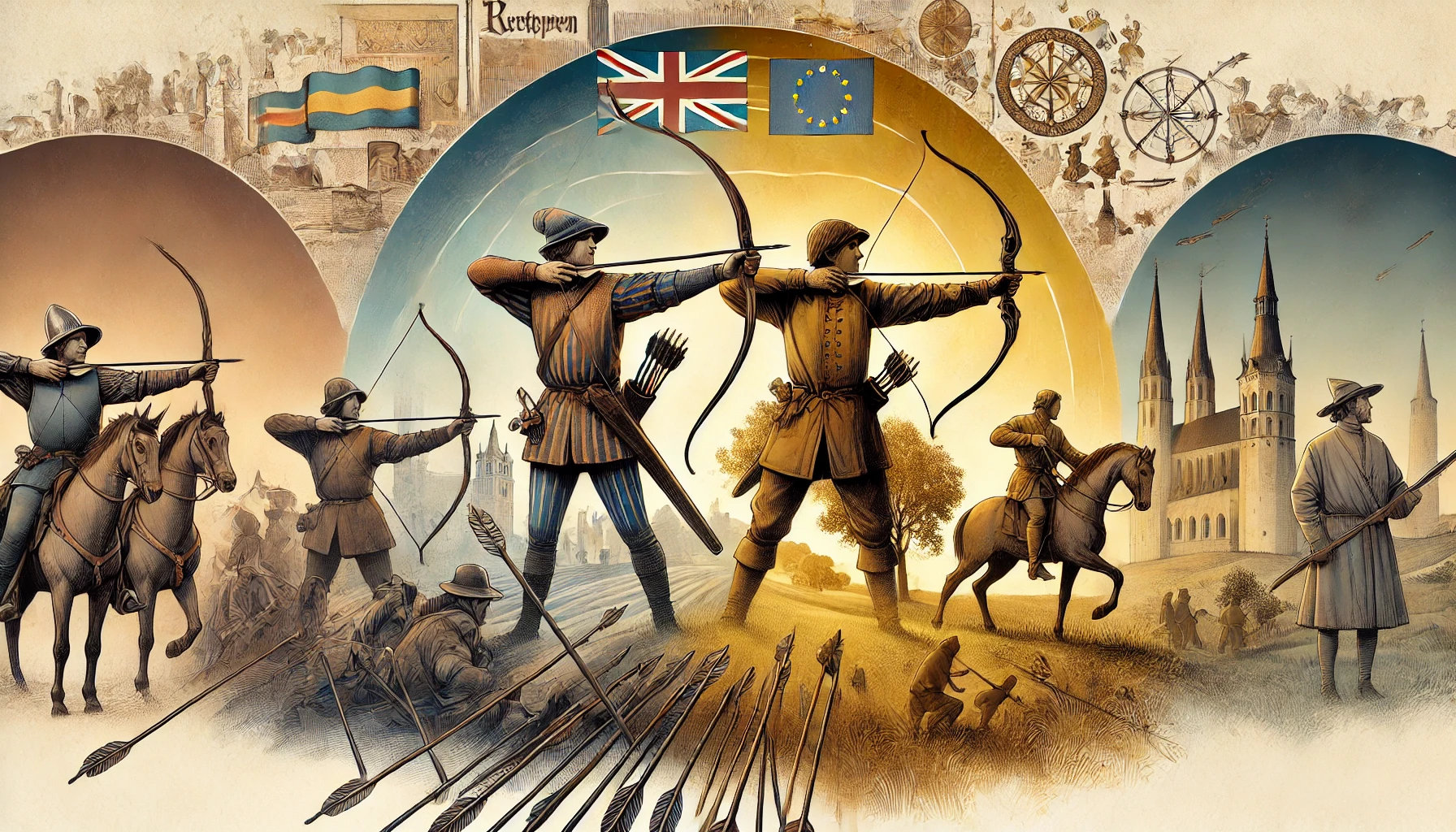Archery has been a defining feature of European history, serving as a tool for hunting, warfare, and later, recreation. The bows used across the continent reflect the diversity of its cultures, resources, and military needs. From the simplicity of the longbow to the sophisticated design of the recurve, the choice of bow was influenced by practicality, cost, environmental factors, and performance. Understanding how these bows were used—and eventually replaced—provides valuable insight into the evolution of European society and warfare.
The Longbow: A Weapon of Simplicity and Power
The longbow is the most iconic symbol of European archery, particularly in England and Wales. Known for its simplicity and effectiveness, the longbow played a pivotal role in defining medieval warfare, particularly during the Hundred Years’ War. It was at battles like Crécy (1346) and Agincourt (1415) that English longbowmen demonstrated their devastating impact on the battlefield.
Why the Longbow Dominated in Western Europe
Several factors contributed to the widespread adoption of the longbow in Western Europe, particularly in England:
- Material Availability: Yew wood, the preferred material for longbows, was abundant in Northern Europe, making it relatively easy to source and produce these bows.
- Cost-Effectiveness: Compared to composite bows, which required specialized materials like horn and sinew, the longbow was far cheaper to manufacture. Composite bows demanded skilled craftsmanship, which increased production costs and time. In contrast, the longbow, made from a single piece of wood, could be crafted more efficiently, saving resources for the English military.
- Environmental Suitability: Composite bows, made of materials like horn and sinew glued together, were highly sensitive to moisture and humidity. The damp climate of Western Europe and England made composite bows less reliable, while longbows, crafted from a single piece of wood, remained durable and effective in such conditions.
- Training Infrastructure: England’s laws mandating archery practice ensured that its populace maintained a high level of proficiency with the longbow, creating a ready supply of skilled bowmen.
Despite its advantages, the longbow was not the most technically advanced bow in Europe.
Recurve and Composite Bows: A Sophisticated Alternative
The traditional recurve bow, with its curved tips that bend away from the archer when unstrung, offers a sharp contrast to the longbow. While it is often associated with steppe cultures, it also found a place in certain parts of Europe, particularly in the East and in regions influenced by nomadic traditions.
Use of Recurve and Composite Bows in Europe
- Byzantine Empire: The Byzantine military made extensive use of composite recurve bows, which were highly compact, powerful, and ideal for mounted combat. These bows were often crafted from a combination of wood, horn, and sinew, resulting in a weapon with exceptional power and range.
- Steppe Influence in Eastern Europe: Nomadic cultures such as the Huns, Avars, and later the Mongols introduced composite recurves to Eastern Europe. These bows were particularly favored in regions like Hungary and the Balkans.
- Western Europe: While recurves and composite bows occasionally appeared in Western Europe, their adoption was limited. The preference for longbows and crossbows in the West was influenced by cultural, economic, and logistical factors.
Comparing Effectiveness: Which Bow Was the Most Powerful?
From a technical perspective, composite recurve bows were the most powerful and efficient bows used in Europe:
- Draw Weight and Power: Composite bows could achieve higher draw weights relative to their size, delivering greater energy to the arrow. Their recurved limbs added mechanical advantage, increasing arrow speed and range compared to a similarly sized longbow.
- Compact Design: The smaller size of composite bows made them ideal for mounted archers and for use in dense, urban environments.
- Versatility: Composite bows were highly adaptable, excelling in both short-range skirmishes and long-distance engagements.
However, their complexity came at a cost:
- Production Time: Composite bows required months to craft due to the layering of materials like horn, sinew, and wood, making them expensive and less accessible.
- Environmental Sensitivity: Their reliance on glue and organic materials made composite bows susceptible to moisture and humidity, limiting their use in damp climates like Western Europe.
In contrast, the longbow’s simplicity, durability, and lower production cost made it the most practical choice for widespread use in England and Wales, even if it wasn’t as technically advanced as the composite bow.
The Decline of Bows in European Warfare
The introduction of firearms in the late 14th century marked the beginning of the end for archery as a dominant military technology. Early guns were slow and unreliable, but their ease of use and ability to pierce armor quickly outpaced the bow.
Where Bows Persisted Despite Firearms
- Hunting and Guerrilla Warfare: The bow’s silence and versatility made it invaluable for hunting and for stealth-based tactics in forested or rural areas.
- Ceremonial and Naval Use: English sailors reportedly trained with bows for emergencies well into the 17th century, and bows often featured in ceremonial roles long after their practical use faded.
The Battle of Pinkie Cleugh (1547) is often regarded as one of the last major military engagements to rely heavily on longbows. By the 18th century, bows had become almost entirely recreational.
Archery’s Transition to Recreation
With the bow’s decline as a military weapon, it transitioned into a symbol of skill, heritage, and leisure.
- Recreational Archery Societies: Groups like the Finsbury Archers in England preserved the craft through organized competitions and social gatherings.
- Romantic Resurgence: In the Victorian era, archery saw a revival as a fashionable pastime, fueled by its association with medieval romanticism and legendary figures like Robin Hood.
- Cultural Preservation: In Eastern Europe and the Balkans, traditional bows like the recurve remained part of cultural ceremonies and martial traditions.
Key Questions About Archery’s Evolution
1. Were Recurve Bows Overlooked in Europe?
Recurve and composite bows were largely confined to Eastern and Southern Europe, influenced by steppe and Byzantine traditions. In Western Europe, the abundance of yew wood, the challenges of composite bow maintenance in humid climates, and the efficiency of longbows and crossbows overshadowed recurves.
2. When Did Bows Become Recreational?
By the late 16th century, as firearms became more reliable and effective, bows transitioned to hunting, ceremonial roles, and recreational activities. Societies and clubs preserved archery as a craft and sport.
3. Why Did Longbows Dominate Over Recurve and Composite Bows?
The longbow was cheaper to produce, more suitable for humid climates, and supported by strong cultural and training systems in England and Wales. Composite bows, while more powerful and efficient, were expensive to produce and less reliable in Western European weather.
A Legacy of Tradition and Adaptation
The evolution of archery in Europe reflects the interplay of geography, technology, and culture. From the longbow’s dominance to the selective use of recurves and composite bows, each choice tells a story of adaptation and practicality. As the bow transitioned from battlefield weapon to recreational tool, it remained a symbol of skill and heritage, connecting modern archers to centuries of history.
This nuanced view of European archery celebrates both its diversity and its enduring legacy, ensuring that the bow continues to inspire new generations.






0 Comments